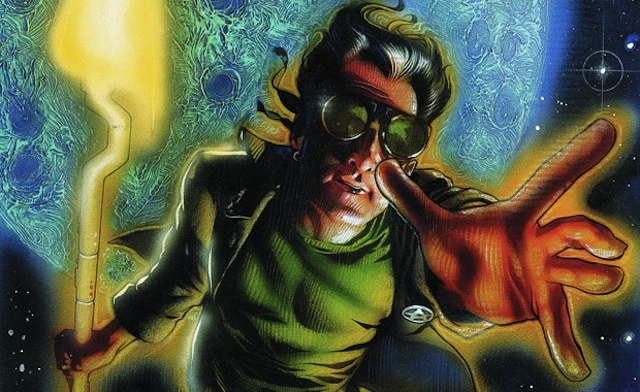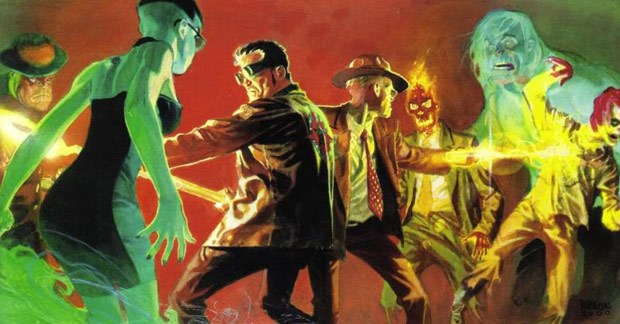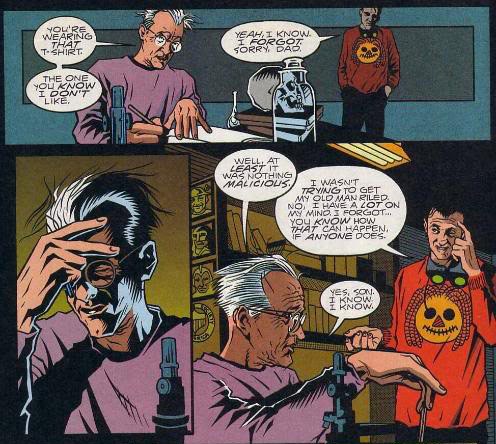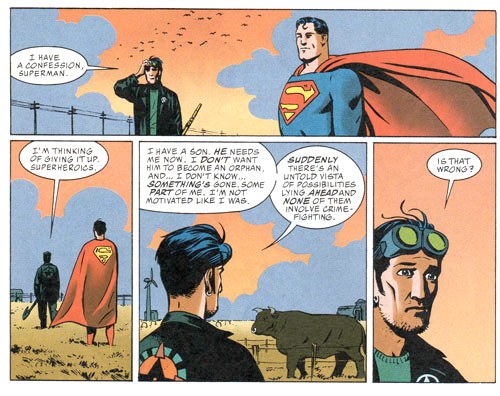Recreating the Golden Age

Oh, it was… err… big and bright and great and easy to understand. The world was simpler.
“No adventure went on for too long, I do recall that. Things were more open and shut. And no one died. At least not often. Nowadays you fly off for a moment, you come back and two or three of your buddies are dead in that time.

A bit player speaks these words in the center of the enormous epic that is DC Comics’ Starman, when asked by a younger colleague what the good old days were like for superheroes. True enough, the world was brighter and simpler for costumed do-gooders on the comic page in earlier days. Stories were exclusively self-contained. Heroes weren’t faced with moral dilemmas, only clear-cut battles of right versus wrong. Characters almost never died or killed, and most certainly didn’t resurrect eight months later if they did. The Golden Age of Comic Books, circa roughly 1938-1950, is looked back on fondly as a time when if you stumbled over a glowing lantern, your only choice was to battle crime (or Hitler) with it by your side. You just did it, no questions asked. It was simply the right thing to do.
Every reader has his or her own golden age of comics, that time when everything is perfect and more importantly, new. It doesn’t matter how many issues of the Justice League I read — none of them are going to feel as innocently perfect as the ones I was reading and swapping with friends at 12 years old. Cynicism takes root in familiarity. It’s why the superhero genre in comics is so focused on recreating that initial joy through reinvention, and why so many readers are often so disappointed in the effort. Like lost childhood toys we still mourn or petty rivalries we never quite let go, we instinctively want to protect and re-experience our most formative memories. To take characters so beloved and attempt to reignite them respectfully for the same (or new) audience is no easy task. But Starman proves it can be done.

Originally published from 1994 to 2001, the series opens with Ted Knight (the Golden Age Starman, first appearance April 1941) passing his heroic mantle to one of his two sons, the eager David, while the sardonic Jack heckles from a nearby easy chair. With one brutal gunshot, a family dynamic is turned on its head and Jack finds himself inheritor to a legacy he neither outwardly wants nor deserves. Opal City needs a protector amidst a resurgence of old rivalries, and Jack is the only one left to wield his father’s cosmic rod. What follows is an incredible 80+ issues, telling an intimate tale of how a father and son repair their damaged relationship amid dark threats and one villain-induced disaster after another. In a genre so rife with missing fathers who drive the actions of their children from beyond the pale (Batman, Superman, Iron Man, Spider-Man, Green Lantern, Mr. Fantastic, The Flash, Spider-Woman, Daredevil — need I go on?), to experience this relationship play out in the flesh is an inspired rarity.
Crafted brilliantly by writer James Robinson, the evolution of Ted and Jack (and even departed David) occurs so naturally that I find it difficult to identify the significant dramatic moments along the way. That is to say, every minor interaction, as in life, propels the characters forward. No need to rely on catastrophic events and head-cradling cries of revenge — the ordinary moments between father and son best uncover their growing respect for one another. As Jack’s insensitivity dulls with every conversation, so too does Ted’s doubt of his son’s true heroism. Ironically, the two Starmen are actually more similar in temperament and ambition than either would care to admit. Even more compelling, both of them already know it deep down, but it takes reflective or conversational moments to make that affinity clear to the reader and to themselves.

Starman is no slouch on action though, especially as illustrated first by penciller Tony Harris and ultimately by artist Peter Snejbjerg. Harris’ gorgeous art deco-inspired layouts and energetic sense of panel construction keep movement on the page frenetic on demand and quiet when necessary. Harris introduces a Jack who is profoundly unsure of himself and his physical capabilities and reinforces that insecurity in the page itself. His Jack Knight is full of swagger and his Ted great exhaustion, but both are clearly façades for real feelings buried under years of emotional distance.
Snejbjerg, who takes the reins slightly past midpoint of the series, doesn’t have Harris’s subtlety of line, but instead infuses an almost Kirby-esque comic book classicism to the book. It’s as if to say, “Kid, you’ve made it.” Now a hero fully realized, Jack encounters his greatest challenges amid space creatures and darkened night rioters to the clean, dynamic style that Snejbjerg aptly provides. Ted Knight’s face glows from within under Snejbjerg’s pencils, beaming with pride as his legacy once again flourishes. Whether depicting swashbucklers, police officers, pin-up girls or astronauts, the art propels characters off the page in equal enthusiasm.
Perhaps what fascinates me most about the portrayal of Jack and Ted is that their respective cynicism and disappointment never dull the true sense of heroism both embody. Certainly, neither character appears unlikable, but Robinson’s care with their dispositions is so balanced so as never to overshadow that true Golden Age trope of doing the right thing simply because it’s right. Whatever disagreements a father and son have, they don’t compare to the lives of innocents or the ultimate importance of family. The father/son dynamic is woven deftly throughout Starman’s many other characters and plot elements, including: the villainous Mist and his progeny, police siblings the O’Dares living up to their father’s legacy, the appearance of Superman’s father Jor-El, and Jack’s own recovery of his newborn son toward the end of the series. In fact, it is with his reunion with baby Theo that the series comes full circle and we get to see Jack accept his father’s true, most personal legacy.

Starman ends far differently than it begins (usually with me a bit teary-eyed), and remains one of the most wonderfully sentimental comic book series I have ever read. Beyond the moving depiction of two men discovering how to finally relate to each other as adults, the book also features one of the final adventures of detectives Ralph and Sue Dibny and builds almost from scratch the fascinating dapper man that is The Shade. Among a pantheon of Golden Age characters rewoven into exciting stories of times past, characters like the Red Bee, Bulletman, Solomon Grundy and the Black Pirate exhibit courage and pathos never before imagined. Robinson manages to take everything we love about comics from our childhood (and his own) and re-place them in an adult tale that respects all that came before. This is the Golden Age all grown up, but never losing the big and bright adventure that made it all so delightfully appealing as a kid.
—
Matt Santori-Griffith owns one business suit, three pairs of shoes, and over 15,000 comic books. He works a day job as an art director for several non-profit organizations, but spends his dark nights and weekends fighting the good fight on Twitter.com in the guise of @FotoCub. He has not yet saved the world, but isn’t giving up quite yet.
Comments
One Response to “Recreating the Golden Age”Trackbacks
Check out what others are saying...[…] Lasting only 18 issues, Firearm was one of James Robinson’s earliest ongoing series and if Starman and the recently released Earth 2 are any indication, I’m going to love this one […]